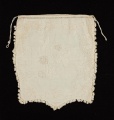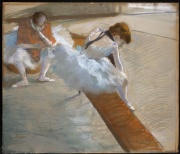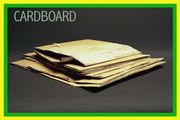Difference between pages "File:51.2411-SC10163.jpg" and "Cardboard"
| Line 1: | Line 1: | ||
| − | '''' | + | [[File:39.669-SC131042.jpg|thumb|Degas 'Dancers Resting'<br>MFA# 39.669]] |
| + | == Description == | ||
| + | [[File:99.664.114-SC33419.jpg|thumb|Box of Pastels<br>MFA# 99.664.114]] | ||
| + | The standard definition is a stiff pasteboard that is thicker than 0.006 inches. However, over the years, the term 'cardboard' has been used for many materials that vary greatly in type and stability. Early cardboards and most current brown cardboards | ||
| + | are produced from wood pulp or recycled papers and as such often contain high amounts of lignin with acidic pH levels. High quality archival cardboard, also called pasteboards, are made from rag pulp and have a low acid content. They are considered durable and permanent and are used for mounting prints, drawings and watercolors. Inferior grades of cardboard, such as corrugated board, are made from coarsely ground sulfite treated wood pulp. The grayish unbleached pulp is pressed into a thick sheet. Cardboard is moisture sensitive, may swell and buckle when wet, and may emit organic acid volatiles. This type of cardboard is most often found in commercial shipping and packaging boxes. The first cardboard box was produced in England in 1817. Corrugated cardboard was patented in 1871. | ||
| + | [[File:image6_cardboard.jpg|thumb|Stack of cardboard]] | ||
| − | + | {| class="wikitable" style="text-align:center" | |
| + | |+<big>Examples of cardboards and alternative products</big> | ||
| + | |- | ||
| + | !General name !! Applications!!Characteristics and/or Commercial Products | ||
| + | |- | ||
| + | !Paste board | ||
| + | |paper board, poster board; boxes, folders||variable; many are inexpensive and non-archival; often contain pigments and fillers; may be textured | ||
| + | |- | ||
| + | !Corrugated board | ||
| + | |packing, boxes, supports, storage, transport, mounting||brown corrugated cardboard is avoided due to its acidic character; may be used when separated from the artifact with a barrier material; blue board | ||
| + | |- | ||
| + | !Archival boards (cellulose) | ||
| + | |exhibition, storage, mounting, encapsulation||[[Alpharag Artcare Museum Board]]; Permec®; PermaDur® Archival Corrugated board; Bi-Corr®; Lineco Archival Backer Board; Corrugated E-flute | ||
| + | |- | ||
| + | !Archival boards (plastic) | ||
| + | |packing, boxes, exhibition, storage, encapsulation||[[Coroplast]], [[Cor-X]], [[Correx]], [[Hi-Core|Hi-Core]], Corrulite, Corulite, and Diversi-Plast | ||
| + | |- | ||
| + | !Foamboard | ||
| + | |boxes, folders, transport, exhibition; signage||lightweight, stiff with smooth laminated surface; may crack under pressure <br>[[Artcare Archival Foamboard|Artcare]]; [[Fome-Cor|Fome-Cor®]]; [[Gatorfoam|Gatorfoam®]]| | ||
| + | |- | ||
| + | |} | ||
| − | + | == Synonyms and Related Terms == | |
| − | + | card board; pasteboard; corrugated board; paperboard; carton (Fr.); karton (Dan., Ned.); Karton (Deut.); | |
| − | + | == Collection Risks == | |
| − | + | * Some cardboards may emit organic acids. | |
| + | * Usually not resistant to puncture or water | ||
| + | * May provide some buffer for temperature and humidity | ||
| + | * Corrugated Board: [[https://askralph.files.wordpress.com/2016/08/corrugated_safety_data_sheet_example.pdf| Cardboard SDS]] | ||
| − | ' | + | == Resources and Citations == |
| − | [https:// | + | * Sherry Guild 'Caring for Paper Objects' Preventive Conservation Guidelines, CCI [https://www.canada.ca/en/conservation-institute/services/preventive-conservation/guidelines-collections/paper-objects.html Link]. |
| + | * Jean Tetreault ''Products Used in Preventive Conservation'' CCI, December 2017. [https://www.researchgate.net/publication/323153775_Products_Used_in_Preventive_Conservation Link] | ||
| + | |||
| + | * ''The Dictionary of Paper'', American Paper Institute, New York, Fourth Edition, 1980 | ||
| + | |||
| + | * E.J.LaBarre, ''Dictionary and Encyclopedia of Paper and Paper-making'', Swets & Zeitlinger, Amsterdam, 1969 | ||
| + | |||
| + | * Matt Roberts, Don Etherington, ''Bookbinding and the Conservation of Books: a Dictionary of Descriptive Terminology'', U.S. Government Printing Office, Washington DC, 1982 | ||
| + | |||
| + | * Reed Kay, ''The Painter's Guide To Studio Methods and Materials'', Prentice-Hall, Inc., Englewood Cliffs, NJ, 1983 | ||
| + | |||
| + | * Hermann Kuhn, ''Conservation and Restoration of Works of Art and Antiquities'', Butterworths, London, 1986 | ||
| + | |||
| + | * Roy Perkinson, contributed information, 1998 | ||
| + | |||
| + | * G.S.Brady, ''Materials Handbook'', McGraw-Hill Book Co., New York, 1971 Comment: p. 582 | ||
| + | |||
| + | * Art and Architecture Thesaurus Online, http://www.getty.edu/research/tools/vocabulary/aat/, J. Paul Getty Trust, Los Angeles, 2000 | ||
| + | |||
| + | * ''CRC Handbook of Chemistry and Physics'', Robert Weast (ed.), CRC Press, Boca Raton, Florida, v. 61, 1980 Comment: density=0.69 | ||
| + | |||
| + | |||
| + | [[Category:Materials database]] | ||
Revision as of 14:43, 20 May 2022
Description
The standard definition is a stiff pasteboard that is thicker than 0.006 inches. However, over the years, the term 'cardboard' has been used for many materials that vary greatly in type and stability. Early cardboards and most current brown cardboards are produced from wood pulp or recycled papers and as such often contain high amounts of lignin with acidic pH levels. High quality archival cardboard, also called pasteboards, are made from rag pulp and have a low acid content. They are considered durable and permanent and are used for mounting prints, drawings and watercolors. Inferior grades of cardboard, such as corrugated board, are made from coarsely ground sulfite treated wood pulp. The grayish unbleached pulp is pressed into a thick sheet. Cardboard is moisture sensitive, may swell and buckle when wet, and may emit organic acid volatiles. This type of cardboard is most often found in commercial shipping and packaging boxes. The first cardboard box was produced in England in 1817. Corrugated cardboard was patented in 1871.
| General name | Applications | Characteristics and/or Commercial Products |
|---|---|---|
| Paste board | paper board, poster board; boxes, folders | variable; many are inexpensive and non-archival; often contain pigments and fillers; may be textured |
| Corrugated board | packing, boxes, supports, storage, transport, mounting | brown corrugated cardboard is avoided due to its acidic character; may be used when separated from the artifact with a barrier material; blue board |
| Archival boards (cellulose) | exhibition, storage, mounting, encapsulation | Alpharag Artcare Museum Board; Permec®; PermaDur® Archival Corrugated board; Bi-Corr®; Lineco Archival Backer Board; Corrugated E-flute |
| Archival boards (plastic) | packing, boxes, exhibition, storage, encapsulation | Coroplast, Cor-X, Correx, Hi-Core, Corrulite, Corulite, and Diversi-Plast |
| Foamboard | boxes, folders, transport, exhibition; signage | lightweight, stiff with smooth laminated surface; may crack under pressure Artcare; Fome-Cor®; Gatorfoam®| |
Synonyms and Related Terms
card board; pasteboard; corrugated board; paperboard; carton (Fr.); karton (Dan., Ned.); Karton (Deut.);
Collection Risks
- Some cardboards may emit organic acids.
- Usually not resistant to puncture or water
- May provide some buffer for temperature and humidity
- Corrugated Board: [Cardboard SDS]
Resources and Citations
- Sherry Guild 'Caring for Paper Objects' Preventive Conservation Guidelines, CCI Link.
- Jean Tetreault Products Used in Preventive Conservation CCI, December 2017. Link
- The Dictionary of Paper, American Paper Institute, New York, Fourth Edition, 1980
- E.J.LaBarre, Dictionary and Encyclopedia of Paper and Paper-making, Swets & Zeitlinger, Amsterdam, 1969
- Matt Roberts, Don Etherington, Bookbinding and the Conservation of Books: a Dictionary of Descriptive Terminology, U.S. Government Printing Office, Washington DC, 1982
- Reed Kay, The Painter's Guide To Studio Methods and Materials, Prentice-Hall, Inc., Englewood Cliffs, NJ, 1983
- Hermann Kuhn, Conservation and Restoration of Works of Art and Antiquities, Butterworths, London, 1986
- Roy Perkinson, contributed information, 1998
- G.S.Brady, Materials Handbook, McGraw-Hill Book Co., New York, 1971 Comment: p. 582
- Art and Architecture Thesaurus Online, http://www.getty.edu/research/tools/vocabulary/aat/, J. Paul Getty Trust, Los Angeles, 2000
- CRC Handbook of Chemistry and Physics, Robert Weast (ed.), CRC Press, Boca Raton, Florida, v. 61, 1980 Comment: density=0.69
File history
Click on a date/time to view the file as it appeared at that time.
| Date/Time | Thumbnail | Dimensions | User | Comment | |
|---|---|---|---|---|---|
| current | 16:48, 20 April 2013 |  | 1,200 × 1,266 (208 KB) | Maintenance script (talk) | Importing image file |
You cannot overwrite this file.


